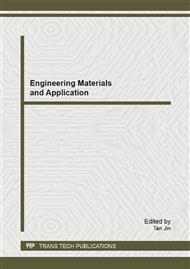[1]
L. E. Anderson, M. Gulati, P. J. Westgate, E.P. Kvam, K. Bowman, M.R. Ladisch, Synthesis and optimization of a new starch-based adsorbent for dehumidification of air in a pressure-swing dryer, Ind. Eng. Chem. Res. 35 (1996) 1180-1187.
DOI: 10.1021/ie9504213
Google Scholar
[2]
K. E. Beery, M. R. Ladisch, Adsorption of water from liquid-phase ethanol-water mixtures at room temperature using starch-based adsorbents. Ind. Eng. Chem. Res. 40 (2001) 2112-2115.
DOI: 10.1021/ie0009381
Google Scholar
[3]
M. Ladisch, K. Dyck, Dehydration of Ethanol: New Approach Gives Positive Energy Balance, Science, 205 (1979) 898-900.
DOI: 10.1126/science.205.4409.898
Google Scholar
[4]
M. Ladisch, M. Voloch, J. Hong, P. Blenkowski, G. Tsao, Cornmeal Adsorber for Dehydrating Ethanol Vapors, I&EC Proc. Des. Develop. 23 (1984) 437-443.
DOI: 10.1021/i200026a005
Google Scholar
[5]
H. Chang, X. Yuan, H. Tian, A. Zeng, Experiment and Prediction of Breakthrough Curves for Packed Bed Adsorption of Water Vapor on Cornmeal, Chem. Eng. Process. 45 (2006) 747-754.
DOI: 10.1016/j.cep.2006.03.001
Google Scholar
[6]
J. Hong, M. Voloch, M. Ladisch, G. Tsao, Adsorption of Ethanol-Water Mixtures by Biomass Materials, Biotech. Bioeng. 24 (1982) 725-730.
DOI: 10.1002/bit.260240314
Google Scholar
[7]
P. R. Bienkowski, A. Barthé, M. Voloch, R. Neuman, M. Ladisch, Breakthrough Behavior of 17. 5 mol% Water in Methanol, Ethanol, Isopropanol, and t-Butanol Vapors Passed over Corn Grits, Biotech. Bioeng. 28 (1986) 960-964.
DOI: 10.1002/bit.260280705
Google Scholar
[8]
L. Anderson, M. Gulati, P. Westgate, E. Kvam, K. Bowman, M. Ladisch, Synthesis and Optimization of a New Starch-Based Adsorbent for Dehumidification of Air in a Pressure-Swing Dryer, Ind. Eng. Chem. Res. 35 (1996) 1180-1187.
DOI: 10.1021/ie9504213
Google Scholar
[9]
M. Ladisch, Biobased Adsorbents for Drying of Gases, Enzyme Microb. Tech. 20 (1997) 162-164.
DOI: 10.1016/s0141-0229(96)00246-3
Google Scholar
[10]
T. Benson, C. George, Cellulose Based Adsorbent Materials for the Dehydration of Ethanol Using Thermal Swing Adsorption, Adsorption. 11 (2005) 697-701.
DOI: 10.1007/s10450-005-6009-1
Google Scholar
[11]
G. Vareli, P. Demertzis, K. Akrida-Demertzi, Effect of Regeneration Thermal Threatment of Cellulosic and Starchy Materials on Their Capacity to Separate Water and Ethanol, J. Cereal Sci. 31 (2000) 147-154.
DOI: 10.1006/jcrs.1999.0255
Google Scholar
[12]
X. Han, X. Ma, J. Liu, H. Li, Adsorption Characterisation of Water and Ethanol on Wheat Starch and Wheat Gluten Using inverse Gas Chromatography, Carbohydrate. Polym. 78 (2009) 533-537.
DOI: 10.1016/j.carbpol.2009.05.012
Google Scholar
[13]
A. Al-Asheh, F. Banat, N. Al-Lagtah, Separation of Ethanol-Water Mixtures Using Molecular Sieves and Biobased Adsorbents, Trans IChemE, Part A, Chem. Eng. Res. Des. 82 (2004) 855-864.
DOI: 10.1205/0263876041596779
Google Scholar
[14]
K. Beery, M. Ladisch, Chemistry and Properties of Starch Based Desiccants, Enzyme Microb. Tech. 28 (2001) 573-581.
DOI: 10.1016/s0141-0229(00)00345-8
Google Scholar
[15]
K. Siroth, Current and Future Perspective of Thai Tapioca Starch Industry, World Tapioca Conference, Thailand, (2009).
Google Scholar
[16]
A. Kosugi, A. Kondo, M. Ueda, Y. Murata, P. Waithanomsat, W. Thanapase, T. Arai, Y. Mori, Production of ethanol from cassava pulp via fermentation with a surface-engineered yeast strain displaying glucoamylase, Renew. Energ. 34 (2009) 1354-1358.
DOI: 10.1016/j.renene.2008.09.002
Google Scholar
[17]
C. Boonfung, P. Rattanaphanee, Cassava-based adsorbent for ethanol dehydration, J. KMUTNB. 20 (2010) 196-203.
Google Scholar


